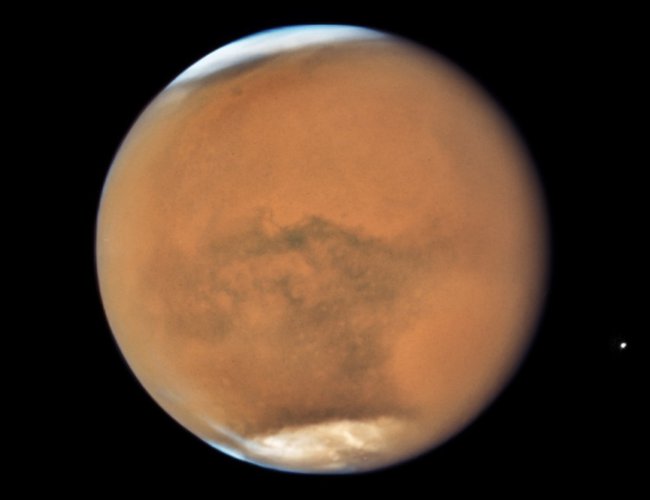
The red planet will be the closest it will be to Earth until 2035, and clear skies over Maryland will make it possible to get a good view.
Mars will be brightest around midnight. To check it out, look high in the eastern sky.
The planet will be visible at night throughout October, rising the highest in the sky around midnight each evening. It will shine in the east each evening and in the west before dawn.
But Mars doesn’t always make an appearance like this. So, why is Mars shining so brightly?
The red planet makes its closest approach to Earth at 10:18 am ET on October 6. Mars will be 38,586,816 miles away from Earth — yes, that’s close for Mars — and it won’t be this close again until 2035. Mars in 2003 made its closest approach to Earth in 60,000 years, coming within a distance of 34.65 million miles.
Today, the Earth will swing between Mars and the sun.
This event, called Mars’ opposition, occurs on October 13, when it will be directly on the opposite side of Earth from the sun, according to NASA.
Mars and Earth don’t orbit the sun in perfect circles or even on the same plane. Instead, the planets have elliptical orbits shaped like ovals.
For example, while Earth only takes 365 days to complete an orbit around the sun, Mars takes 687 days. When Earth moves closer to the sun, Mars moves away from it.
Currently, NASA’s Perseverance rover is zipping through space and on its way to landing on Mars in February 2021. It’s one of several missions en route to Mars, including the United Arab Emirates’ Hope probe and China’s Tianwen-1.
Perserverance launched on July 30, specifically within a time frame that would allow for a quicker journey between Earth and Mars when they’re in alignment on the same side of the sun.
In addition to beautifully bright Mars, look out for other planets lighting up the sky. Venus, which is the third brightest object in the night sky after the sun and the moon, is still brighter than Mars — it only appears so in the morning.
Mars reigns supreme in the night sky right now and Venus shows off its brightness in the eastern morning sky, according to EarthSky, a nonprofit organization and astronomy website. Mars is even outshining Jupiter throughout October.
But once Mars fades from view, Jupiter will be one of the brightest objects in the evening sky, and Saturn will also be visible to the east of Jupiter.
This is because of a conjunction of Jupiter and Saturn. The two largest planets in our solar system are having a rare meeting that occurs every 20 years.
The conjunction officially occurs on December 21, 2020, but both planets are visible now in proximity to each other and will be for the rest of the year in the night sky.
Jupiter outshines the stars, while Saturn gives off a bright golden glow. During the last great conjunction in 2000, the two giant planets were near the sun from our perspective on Earth, making them difficult to see.
The reason this conjunction is rare is due to the orbits of these giant planets — Jupiter takes 12 Earth years to complete one orbit around the sun, and Saturn takes 30 years.
And every 20 years, Jupiter catches up with Saturn from our perspective on Earth. So take advantage of this rare opportunity to see both close together in the night sky.
It's a beautiful month for Mars watching as the planet camps out. October 2020 is all about the glory of Mars as the glimmering red planet puts on a show in the night sky. We passed Mars' close approach to Earth on Oct. 6 and now we can look forward to Tuesday, Oct. 13, when it will be in opposition.
Spotting Mars
Mars has a reputation as the "red" planet, but its color in the night sky is a little more on the Halloween side of the spectrum. It appears as a bright orange-red dot to the naked eye, like a little spot of glittering rust.
Mars' distinctive color is one clue you've found it in the dark. Look to the eastern sky to catch it rising at night. This is a great time for viewing the planet, partly because spotting it is so simple. It should be visible for most of the night. As NASA says, "Simply go outside and look up and, depending on your local weather and lighting conditions, you should be able to see Mars."
When Mars and the sun line up with Earth in the middle, the red planet is said to be in opposition. This is a perfect time to track Mars' movement across the sky. It will rise in the east as the sun goes down, move across the sky and then set in the west as the sun comes up.
NASA describes opposition as "effectively a 'full' Mars." Tuesday, Oct. 13 is the time to enjoy opposition. You'll have to wait over two years for it to happen again.
The Virtual Telescope Project, which brings us live feeds of celestial events, will stream a Mars opposition viewing starting at 1 p.m. PT. on Oct. 13. It's a perfect way to enjoy the action without weather worries. For people in the US, it will give you a preview of what to look for after sundown.
The project expects this to be "the best observing conditions since July 2018."
"The racetrack model of planetary orbits explains why. Earth and Mars are like runners on a track. Earth is on the inside, Mars is on the outside," NASA said in its "Every 26 months, speedy Earth catches up to slower Mars and laps it. Opposition occurs just as Earth takes the lead."
Mars isn't the only show-off in the sky for October. You can also look forward to a rare Halloween blue moon when our lunar neighbor is full on Oct. 31. It's not spooky; it's boo-tiful.
Rewind to the close approach on Oct. 6
Tuesday, Oct. 6 marked the close approach of Mars to Earth, but this entire month is still a good time to grab a telescope and get a little better look. Give a wave to NASA's Perseverance rover while you're at it. The vehicle is on track to reach the planet in February 2021.
NASA shared an artist's view of the Tuesday, Oct. 6 close approach compared with the last time it snuggled up in July 2018. The apparent sizes look very similar. This year, Mars had a minimum distance of 38.6 million miles (62 million kilometers), which is about 3 million miles farther away than in 2018.
This artist's view shows the apparent sizes of Mars during close approaches in 2018 and 2020.
Close approach may be over, but the planet is still plenty bright in the night, so get out and take a gander, or tune into the Virtual Telescope Project's live feed from the comfort of your computer.
- PM Oli Returns Home Attending UN FFD4 Summit
- Jul 05, 2025
- Trump signs into law domestic policy bill
- Jul 05, 2025
- Putin-Trump call after US halts some arms shipments to Ukraine
- Jul 04, 2025
- USAID programs officially suspended
- Jul 03, 2025
- Thailand’s Constitutional Court suspended PM Paetongtarn Shinawatra
- Jul 02, 2025















